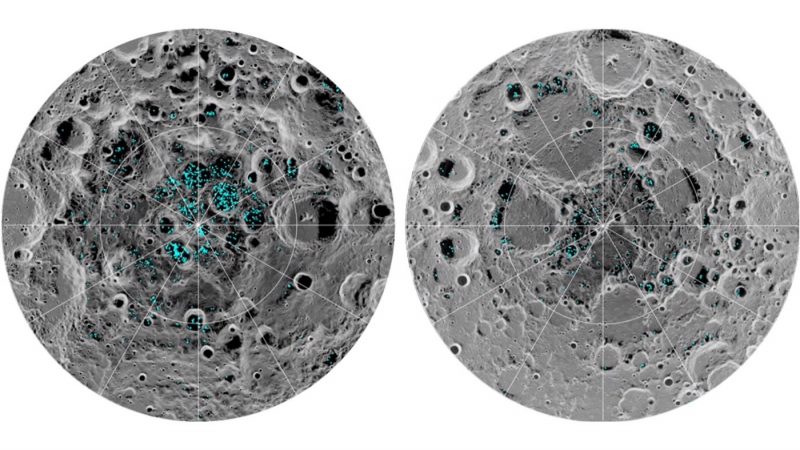
Space scientists have been speaking for years about the possibility of water ice preserved in shadowed craters at the moon’s poles. The presence of such ice raises the possibility of a formerly habitable moon, and also a moon we earthlings can inhabit as a platform for future solar system exploration. Today – August 21, 2018 – scientists at NASA announced the first direct observations providing definitive evidence of water ice at the moon’s poles. NASA said:
These ice deposits are patchily distributed and could possibly be ancient. At the southern pole, most of the ice is concentrated at lunar craters, while the northern pole’s ice is more widely, but sparsely spread.
The work was published in the peer-reviewed Proceedings of the National Academy of Sciences on August 20.
Shuai Li of the University of Hawaii and Brown University along with Richard Elphic of NASA’s Ames Research Center in California used data collected by NASA’s Moon Mineralogy Mapper (M3) instrument, which flew aboard Chandrayaan-1, India’s first mission to the moon, launched in 2008. The instrument provided the first mineralogical map of the lunar surface. In the new work, the researchers said they used M3’s data to identify:
… three specific signatures that definitively prove there is water ice at the surface of the moon.
They added that M3 was:
… uniquely equipped to confirm the presence of solid ice on the moon. It collected data that not only picked up the reflective properties we’d expect from ice, but was able to directly measure the distinctive way its molecules absorb infrared light, so it can differentiate between liquid water or vapor and solid ice.
Most of the newfound water ice lies in the shadows of craters near the poles, where the warmest temperatures never reach above minus 250 degrees Fahrenheit [-121 Celsius]. Because of the very small tilt of the moon’s rotation axis, sunlight never reaches these regions.
Previous observations indirectly found possible signs of surface ice at the lunar south pole, but these could have been explained by other phenomena, such as unusually reflective lunar soil.
They pointed out that this surface water-ice on the moon might:
… be accessible as a resource for future expeditions to explore and even stay on the moon, and potentially easier to access than the water detected beneath the moon’s surface.
Learning more about this ice, how it got there, and how it interacts with the larger lunar environment will be a key mission focus for NASA and commercial partners, as we endeavor to return to and explore our closest neighbor, the moon.

Bottom line: Researchers say they have directly confirmed ice at the moon’s poles.
Source: Direct evidence of surface exposed water ice in the lunar polar regions











